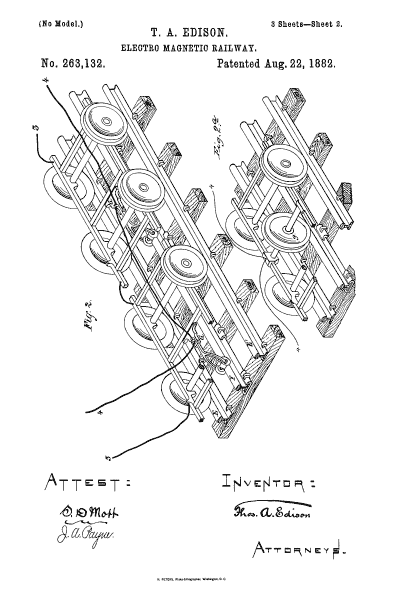The "third rail"
It is claimed on dozens of websites that Granville Woods invented the "third rail" that conveys electric power to subways and other rail vehicles. You can see in the following examples that third-rail technology was already a couple of decades old before Woods supposedly "invented" it in 1901.
Siemens, 1879
Werner Siemens demonstrated a small electric railway at the Berlin Industrial Exhibition (Berliner Gewerbeausstellung) in 1879. The motor of the locomotive received power from a live third rail laid between the two track rails.

Siemens described the railway in a patent:
...the electric railway which was publicly used by me, E.W. Siemens, in the city of Berlin, in the year 1879....
Between the two rails upon which the vehicle traveled a middle rail, insulated upon wood or in any other proper manner, was made use of for transmitting the current, and both of the track-rails were made use of for the return-current. The electrical connection between the rail running in the middle between the two track-rails and the electro-dynamic motor of the locomotive was effected by means of metallic brushes attached to the car-frame in an insulated manner, and the gap in the circuit thus formed between the brushes and the frame was closed by the copper wire of the electro-dynamic motor and by a switch provided with artificial resistances, by leading an insulated wire from the brushes upon the rail to one of the poles of the electro-dynamic motors of the locomotive, and another insulated wire from the car-frame through the switch to the other pole of the motor.
E. Werner Siemens, in US patent #324176
Leo Daft, 1883
English-born Leo Daft also used a third rail in what was perhaps the first standard-gauge electric railway in the United States. A public demonstration of the system was reported in the New York Times, Nov. 25, 1883:
During the past two years Mr. Leo Daft, an electrician of repute, has been experimenting with a motor at his laboratory in Greenville, near Jersey City. His purpose has been to perfect a machine, which, propelled by electricity, should be capable of operating on railways and take the place of the steam locomotive.
This afternoon Mr. Daft gave the first practical exhibition of the motor on the Saratoga, Mount McGregor and Lake George Railroad, a line about 12 miles long, with sharp curves and steep grades. The Daft Electric Light Company, of New-York, which controls the motor, brought a party to Saratoga to-day to witness the motor's workings. There were between 60 and 70 gentlemen from New-York, Brooklyn, Newark, Boston and other cities.
[ . . . ]
Along the centre of the track a third rail was laid, and from this rail the electric power was taken up by the motor. The electric current in this instance was generated by dynamos at a factory one-eighth of a mile from the railway station and 500 feet from the track, to which it was led through wires. The generating engine was 25-horse power. The current is fed to the central track and is taken therefrom by a contact wheel, which in turn transmits it to a receiving dynamo and causes the revolution.
MR. DAFT AND HIS MOTOR, New York Times, Nov. 25 1883, p. 2
The experiment ended when the driver sped around one of the curves too fast, causing the vehicle to jump the track.
In 1885, Daft built his first commercial third-rail system on the Baltimore & Hampden lines. It was discussed in the Manufacturer and Builder :
...since September 1st, 1885, electricity has been practically employed as the motive power for one of the suburban lines of surface railroad in Baltimore. The system used is that of Mr. Leo Daft....
An insulated steel rail, laid between the track rails, and roughly guarded by joists and planks laid on each side of it, serves as a conductor. The sections of this conducting rail, as also of the track rails, are electrically connected by wires.
"The Electric Motor in Baltimore," Manufacturer and Builder, February 1886, p. 37
City of London and Southwark Subway, 1890
A third rail transmitted power to the world's first electric subway trains, which debuted in London in late 1890.
The road runs from the Monument, in King William Street, near the north end of the London Bridge, southward under the Thames River to Southwark, and is three and a half miles long.
The road is laid with seventy-pound steel rails and the motive power is electricity. The electric current is transmitted along a third rail which is laid for the purpose between the two other rails, and is transmitted to the armature on the axle of the engine by brushes.
AN UNDERGROUND ROAD, New York Times, Dec 27 1890, p. 5
Metropolitan Elevated Railway in Chicago, 1895
Instead of a dangerous overhead trolley wire, a third rail is run along the outside of the track. This rail is raised several inches above the track, and the electric current is conducted from the station to this rail by heavy feeder cables.
TO RUN BY ELECTRICITY, New York Times, Jun 1 1895, p .1
Elevated Railway in NYC, 1896
The elevated structure will be equipped with a third rail to carry current to the trains. The storage battery on the locomotive and the motor will be connected in parallel with this third rail. Electric current will be conveyed by this third rail to the locomotive from a power station near the lines.
ELECTRICITY TO BE TRIED, New York Times, Feb 5 1896, p .16
Thomas Edison
Edison patented his first third-rail power pickup system in 1882.
